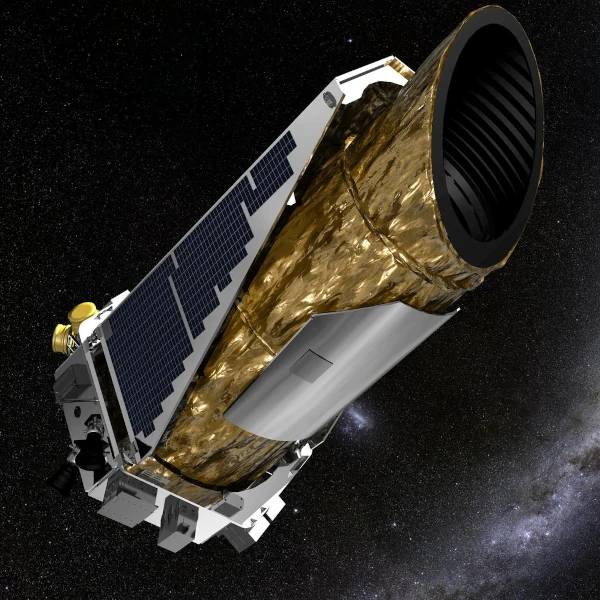
Launched by NASA in March 2009, the Kepler space telescope radically transformed our understanding of the cosmos. Designed to continuously monitor over 150,000 stars in a fixed portion of the sky located between the constellations Cygnus and Lyra, Kepler sought the tiny signature of a planet transiting in front of its star. This method of observation, with unprecedented photometric precision, allowed the detection of thousands of extrasolar planets, often the size of Earth. By 2024, more than 4,000 exoplanets had been confirmed thanks to Kepler, with thousands more awaiting confirmation.
The fundamental principle of the mission relies on the so-called transit method: when a planet passes in front of its star, it temporarily decreases the received brightness. Kepler measures these variations with a relative precision on the order of \(10^{-5}\), thus allowing the detection of terrestrial-type exoplanets. The amplitude of the light attenuation \(\Delta F/F\) is given by the ratio of the surfaces: \[ \frac{\Delta F}{F} \approx \left( \frac{R_p}{R_\star} \right)^2 \] where \(R_p\) is the radius of the planet and \(R_\star\) that of the star. An Earth in front of a Sun induces a signal of only 0.0084%.
Kepler's field of observation covers only 0.25% of the sky, equivalent to an outstretched hand at arm's length. Yet, in this restricted region, Kepler has uncovered a plethora of worlds ranging from gas giants to rocky planets, some in the habitable zone of their star. The distribution of planetary radii reveals an unexpected abundance of super-Earths (between 1.5 and 2.5 times the Earth's radius) and mini-Neptunes, categories almost absent from our solar system.
Kepler's results now allow us to extrapolate the potential number of planets in our galaxy. According to statistical data from the mission, it is estimated that about 20 to 50% of solar-type stars could host a rocky planet in their habitable zone. This corresponds to tens of billions of potentially habitable worlds in the Milky Way alone. The mission has thus laid the foundations for a new celestial cartography, no longer based solely on stars, but on their planetary systems.
Despite the official end of the mission in October 2018, following the failure of its gyroscopes, Kepler's data continues to fuel research. Its successor, the TESS (Transiting Exoplanet Survey Satellite) telescope, inherits its approach but with a much wider field of observation. Kepler marked an epistemological turning point: it confirmed that planets are the rule, not the exception. It also offered a robust statistical framework for comparative planetology, opening an era where distant worlds are no longer hypothetical objects, but measured entities.
Kepler observed only an infinitesimal fraction of the sky, yet it discovered thousands of worlds. By extrapolating these results, it becomes evident that our galaxy is teeming with planets, some very different, others remarkably similar to Earth. By drawing this new map of the sky, Kepler has profoundly changed our relationship with the universe: we no longer ask if other worlds exist, but how many, where, and when we will be able to explore them.
| Name | Radius (Earth = 1) | Mass (estimated, M⊕) | Orbital Period (days) | Distance to Star (AU) | Host Star | Spectral Type | Habitable Zone | Year of Discovery |
|---|---|---|---|---|---|---|---|---|
| Kepler-186f | 1.11 | ~1.4 | 129.9 | 0.36 | Kepler-186 | M1V | Yes | 2014 |
| Kepler-452b | 1.63 | ~5.0 | 384.8 | 1.05 | Kepler-452 | G2V | Yes | 2015 |
| Kepler-62f | 1.41 | ~2.8 | 267.3 | 0.72 | Kepler-62 | K2V | Yes | 2013 |
| Kepler-442b | 1.34 | ~2.3 | 112.3 | 0.41 | Kepler-442 | K5V | Yes | 2015 |
| Kepler-438b | 1.12 | ~1.3 | 35.2 | 0.17 | Kepler-438 | M | Yes | 2015 |
| Kepler-1649c | 1.06 | ~1.2 | 19.5 | 0.065 | Kepler-1649 | M5V | Yes | 2020 |
| Kepler-1544b | 1.48 | ~2.6 | 168.8 | 0.59 | Kepler-1544 | K | Yes | 2016 |
| Kepler-1652b | 1.60 | ~3.7 | 38.1 | 0.23 | Kepler-1652 | M | Yes | 2016 |
| Kepler-705b | 1.22 | ~1.6 | 58.0 | 0.29 | Kepler-705 | M | Yes | 2016 |
| Kepler-296e | 1.75 | ~4.0 | 34.1 | 0.18 | Kepler-296 | M1V | Yes | 2014 |
Sources: NASA Exoplanet Archive (2024), Torres et al. (2015), Rowe et al. (2014), Morton et al. (2016), Dressing & Charbonneau (2015), Chen & Kipping (2017), Barclay et al. (2015), NASA Ames.